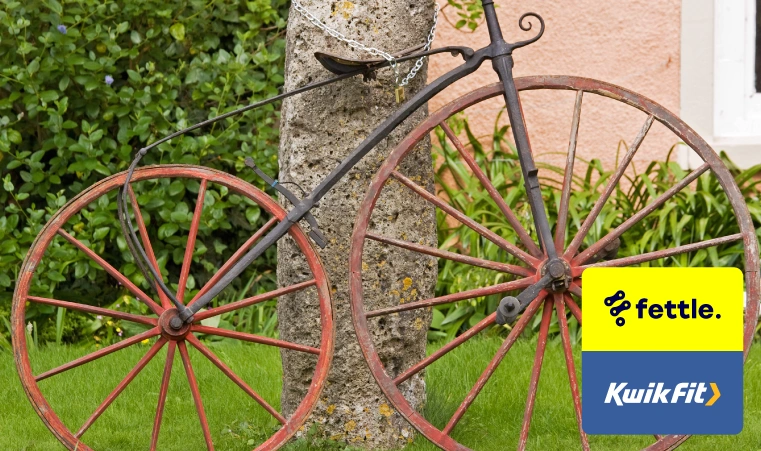Who Invented the Bicycle, and When?
Jack Dreyer | Friday 10th November 2023 9:30am

The bicycle is, arguably, one of the most fuel-efficient modes of transport ever created. With zero emissions, it’s allowed millions (if not billions) of people around the world to easily and cheaply get themselves from A to B. Specifically, it was the bicycle that first began to really connect rural communities before everyone could afford a carriage with real horsepower.
Previously, if you wanted to get anywhere, you’d either have to walk, hitch a ride on a cart, or be wealthy enough to own a horse – which, despite what medieval TV shows portray, was quite a minority of people. The bike changed a lot of that. But who actually invented the bicycle, and when?
Let’s find out.
The Draisienne, a proto bike
In 1817, German inventor Karl Drais (who, incidentally, is claimed and refuted to have also invented the earliest typewriter) invented what he called the ‘Laufmaschine’ (literally ‘Running machine’) to help speed up transport without relying on horsepower. This has proved to be the earliest example of a workable ‘bicycle’ but didn’t actually feature cycling.
The Laufmaschine was also known by a number of other names. You may have read of “hobby-horses”, “velocipedes”, or “dandy horses”, but they’re now most commonly known as Draisiennes – to mark the inventor’s name.
You’d probably also recognise the draisienne as a bicycle if you saw it. It has a steerable front wheel, a brake, and a height-adjustable seat – quite high tech for two hundred years back!
To get going, riders had to sit astride it and push themselves forward. This seems silly, but when you imagine how much faster you can go on a bicycle by just running forward and rolling with the momentum, this actually proved to be quite a practical mode of transport. With the average human walking speed of 3mph, being able to go even 5mph would almost halve your journey time.
The fad for Draisiennes, however, didn’t last for very long. People very quickly realised that the condition of most roads wasn’t particularly suitable for the Draisienne – you’d keep getting tripped up by cart ruts – so, they took to footpaths and posed some (if overblown) danger to pedestrians. This, in turn, led to their widespread banning in almost everywhere they’d become popular.
A quadricycle made in Dover
The next closest thing to a “bicycle” as we’d know it today is likely a contraption designed by a Dover carpenter in the 1850s called Willard Sawyer – the Quadricycle. This looks similarly archaic to the Draisienne but looks considerably more mechanical.
Essentially, you put your feet into stirrups astride a central section and crank the two front wheels in a motion very similar to skiing or that of a cross-fit machine. Interestingly, it was steered from behind because the front wheels turning would get in the way of your legs.
The first real bicycle: a French “Boneshaker”

Not long after, we get what’s closest to the first real bicycle with the design of French blacksmith Pierre Michaux. Bike looked a lot like a refined velocipede but, notably, featured a foot-cranked front wheel. Michaux and his company were the first to mass produce something like a bicycle. They called it the ‘Michaudine’.
The Michaudine was known as the ‘boneshaker’ because it was made entirely out of cast iron and wood. The frame was a pretty, if heavy, ‘serpentine’ shape but the wheels were essentially the same as carriage wheels: wood with a strip of iron along the whole face of the wheel.
This, coupled with the cobbly streets they were most likely to be cycled on, made for a terribly uncomfortable experience. Innovations did happen along the way, like adding solid rubber instead of the iron strip. This helped with comfort slightly but was a long way off John Boyd Dunlop’s tyres.
The Penny Farthing
Interestingly, it was precisely because of being reasonably small and front-wheel driven that the early forms of Velocipede evolved into the penny farthing in the 1870s. On most surfaces, Velocipedes would end up being quite unstable. The steering handlebars were quite short, so bumps, dips, and ruts in the road surface would easily make your riding unstable – picture going downhill at speed on a bike too small for you!
The odd look of penny farthings was created by British engineer and inventor James Starley in order to make them a lot more stable: with a much bigger front wheel, there’s less wobble on rough surfaces and more centred momentum. Having a bigger leading wheel also means you could reach higher speeds than you otherwise could on a cranked velocipede.
It was actually just called a “bicycle” at the time, but the dramatic size difference between the two wheel is what led to its nickname of “penny farthing” – with a penny being the larger coin and a farthing being a smaller one.
Starley’s innovations didn’t just stop at the large wheel; a lot of design features we now take for granted on modern cycling, things like ball bearings, tangential spokes, and hollow-section steel frames, originated with Starley.
The first real bike: the safety bicycle
Penny farthings looked striking and could reach high speeds, but they were also considerably dangerous to ride. Your seat height while riding would often be around two metres above the ground surface. At speeds, a small bump could easily throw you head first onto unforgiving roads.
For quite some time, then, the penny farthing didn’t represent a practical mode of transport but a dangerous, sporty pastime to occupy young men with money.
It was James Starley’s nephew, John Kemp Starley, who invented what’s the first most-recognisably modern bicycle to meet the concerns of the penny farthing in 1885. It very quickly came to be called a “safety bicycle” due to its improvements. It featured 26 inch wheels (both the same size), wide handlebars, a steerable front wheel with a large turning angle, and featured a chain drive connected to the back wheel.
Suddenly, people had access to a genuinely efficient mode of transport, pedal powered, and not at significant risk of breaking wrists and necks. To reflect the new freedom available with these bikes, Starley called the first model the “Rover” – and his company then went on to become the manufacturer of motorcycles and cars famous around the world.
Since the safety bicycle
The safety bicycle is essentially the first modern bike. All innovations since then have been essentially marginal (like adding brakes, gears, suspension, and pneumatic tyres) to increase usability, safety, and comfort.
If your bike’s proving less than comfortable, perhaps it needs a good check-up, tweak, and service! We’ve teamed up with the bike servicing experts, Fettle, to offer bicycle and e-bike servicing right in our centres.
Any facts, figures and prices shown in our blog articles are correct at time of publication.
Featured Articles
Is it Illegal to Drive With One Headlight?
Saturday 19th July 2025
Wondering if it’s illegal to drive with one headlight? Learn about the safety risks and penalties of illegal blown bulbs and why you should fix them promptly.
Air Con in EVs & Hybrids: Experts Answer Your Questions
Monday 30th June 2025
Does air con drain EV batteries? Can you use the air con while charging an electric car? Find out the answers to these questions & more from Kwik Fit’s experts.
Why Is Your Car Making a Noise? Fixes & Tips
Friday 13th June 2025
When your car starts making unexpected noises, it can certainly be quite disconcerting; it may be nothing to worry about, but here’s what you need to know.









